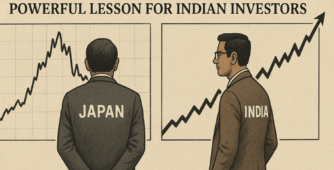
The Indian stock market has witnessed a significant rise in retail investors dabbling in options trading. This trend has raised concerns among regulatory authorities, such as the Securities and Exchange Board of India (SEBI), who recently released a report stating that over 90% of people in the market end up losing money. This alarming statistic indicates a need for further analysis and potentially stricter regulations to protect inexperienced investors from making uninformed decisions in the derivatives market.

A recent article in Fortune India shed light on the dominance of derivatives trading in the Indian market.
According to the article, a staggering 99.6% of market volumes are now in derivatives, with equity derivatives accounting for 99.6% of the trading volumes, translating to over $4.3 trillion per day. These volumes amount to 125% of the underlying market cap and 200% of the free float. In other words, every day, the value of derivatives trades is 1.2 times the size of the entire Indian stock market.
The article refers to these traders as “options warriors” who have taken over the market to a significant extent. A comparison with the US market reveals a massive disparity. In the US, derivatives account for only 70% of trading volumes, while in India, that number stands at a staggering 99.6%. This striking difference signifies the overwhelming dominance of options trading in the Indian market.
The exponential growth of options trading in the last two decades can be attributed to various factors. With heavy taxation on the gaming industry, casinos, and lotteries in India, options trading has become an alternative for hardcore speculators. It offers a convenient and accessible trading instrument for those seeking quick profits.
The ease of entry into the options market has attracted a large number of young individuals, many of whom have abandoned their careers to pursue trading. However, the concern arises when it becomes apparent that these traders lack proper investment or trade orientation. Instead of a long-term investment strategy, the focus seems to be on making a quick buck. This mindset is further reinforced by the alarming statistics from SEBI, which indicate that 90% of traders end up losing money, with an average loss of ₹56,000 per person. On the other hand, only 10% of participants made a profit, amounting to ₹6,900 crores.
The socio-economic implications of this trend are worrisome. As the majority of retail traders lose money, there is an inherent transfer of wealth to intermediaries, including brokers and the government. This transfer occurs through various transaction costs, including brokerage fees and taxes. While these intermediaries benefit from the high volume of trades, the overall societal impact of this loss for retail investors is not favourable.
Additionally, the dominance of derivative trading can lead to extreme market movements. With derivatives trading volumes far surpassing cash market volumes, the proverbial “tail wagging the dog” scenario comes into play. In other words, the derivative market has the potential to influence the entire stock market, leading to substantial volatility and unanticipated risks.
Considering these concerns, it is imperative for regulators, such as SEBI, to address the issue and create a more structured trading environment. While the democratisation of the market is a positive development in terms of increased participation, it is crucial to ensure that investors are adequately informed and protected from potential financial losses.
Some measures that might be considered are the introduction of barriers to entry, such as higher costs or thresholds for retail trading. Although such regulations may face resistance and may not be a popular opinion, they can help prevent uninformed investors from making reckless decisions in the market, contributing to a more stable and sustainable trading environment.

If you have any questions, please write to support@weekendinvesting.com









